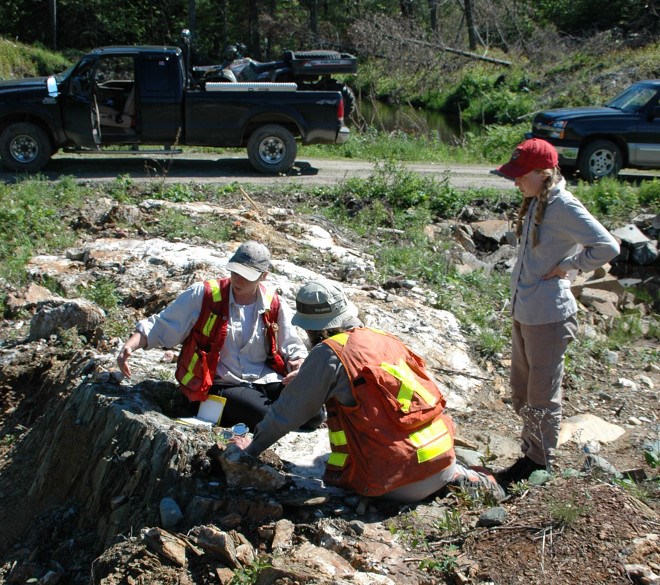Gold and palladium prices are reaching lofty heights but there continue to be troubling signs on the grassroots side of Ontario’s mining industry.
Garry Clark, executive director of the Ontario Prospectors Association (OPA), said the mining sequence of discovery and development is faltering right now.
Since the economic crash of 2008, investor interest in early-stage exploration has largely been in the dumper, despite the uptick in value of various mineral commodities.
“Grassroots exploration isn’t happening as much as it should,” said Clark.
Part of problem, he said, has been competition for investor attention from other high-risk, high-reward ventures such as Bitcoin, Blockchain and marijuana stocks.
The OPA has been pushing the government for more incentives to stimulate the exploration side of a $10-billion industry and spotlight the province as one of the world’s best mining jurisdictions.
The conditions are prompting the OPA to make internal structural changes.
Besides the cosmetic rebranding, the intent to become more of an effective lobby group to better represent its 700 members at Queen’s Park, and be more visible to the general public, who have little idea on what the grassroots stage of the industry actually does.
One item under consideration is the appointment of a full-time president and CEO.
Since being handed the OPA’s reins in 2001, Clark has handled the duties on an ad-hoc basis out of his geological consulting firm’s office in Thunder Bay.
“We want to try and change the focus, as not just prospectors but try and capture the junior companies. We do that fairly well, but I don’t think that’s overly reflected to the junior companies.”
The Ontario Mining Association represents operating mines in the province, leaving the OPA to be the voice of a critical bridge between exploration and production.
Junior mining companies, Clark pointed out, do the bulk of the industry’s heavy lifting in conducting the due diligence and in-depth exploration to push deposits down the development pipeline into operating mines.
The OPA is also waging a campaign to convince the Ford government to increase the provincial flow-through share tax credit to help fuel exploration.
Flow-through shares have historically been the exploration industry’s lifeline during commodity downcycles.
The exploration community is circulating an online petition to boost the credit from 5 per cent to 25 per cent to put Ontario on a competitive plain with other provinces like Québec (38.75 per cent) and British Columbia (30 per cent). Ottawa provides a complementary federal tax credit of 15 per cent.
The introduction of online claim-staking in Ontario is fundamentally changing the face of the exploration sector.
The ability to electronically stake ground by computer has attracted foreign investment for advanced exploration projects.
On the flip side, Clark said, it cuts into the extra income bush-whacking prospectors made from being contracted to do linecutting, blazing trees, and hammering posts.
There’s also the chronic problem of a greying pool of explorationists.
“There are not a lot of young people in prospecting,” Clark said. “These are big issues.”
That translates to fewer trained eyes finding new discoveries in unexplored areas.
Most of the activity in Northern Ontario, Clark said, is happening along well-known mineralized trends, around former mine properties, and next to operating mines, in the so-called ‘shadow of the headframe.’
“You’re not coming up with new showings; you’re still chasing down old showings.
"The industry is still very busy, it’s hard to find labour, but they’re all working close to mines or advanced deposits.”
That’s why Clark is seeking to secure from Queen’s Park a second iteration of the highly successful Junior Exploration Assistance Program (JEAP), a rebate program launched by the previous Wynne government in 2015.
Great Bear Resources and their Dixie Gold Project, 20 kilometres south of Red Lake, are the poster boys of the $5-million incentive program.
The Vancouver company used their $100,000 in JEAP funding for a drill program that catapulted them to a second phase of exploration that produced a high-grade discovery hole.
“When we gave them the money, their market cap was under $5 million,” said Clark. In early February, it was approaching $394 million.
With the company cashed up with $29 million for exploration in 2020, Dixie’s full potential has yet to be realized as Great Bear is shaping to be one of the most attractive takeover targets in recent years.
“They’ll write us a letter all day about how good the program was,” said Clark.
The JEAP program funded 42 projects, some of which moved to the next stages of exploration.
For every dollar the provincial government invested, the companies were able to raise money on the street at ratios of 18:1 that were applied in the later rounds of exploration.
The JEAP program wrapped up a year and half ago.


